Amsterdam , 2018
IS MY BODY PUBLIC?
Performance made in several cities. Dresses made with fifteen different languages. During the performance 15 women walk through the streets of Amsterdam wearing the dresses as a new way of demonstrating sexual violence and intimidation against women.
Languages: Arabic, Chinese, Dutch, English, French, German, Japanese, Korean, Portuguese, Russian, Spanish, Swahili, Thai, Turkish, Urdu.
For this work Framis has new garments with which she explores the borders of that which is private and that which is public. The aesthetics of the dresses resemble that of lingerie, a material usually associated with the private realm, with moments of intimacy inside the home environment. The dresses are made from tulle, a delicate and transparent fabric, but are at the same time banners for public demonstration and used as such.
The dresses carry a strong message embroidered onto them. “Is My Body Public?” ask each of the fifteen dresses, in fifteen different languages. With the work, Framis wants to focus attention on the issue of women’s control over their own body. The slogan “Is My Body Public?” was translated by fifteen different women, each from the region where the specific language is spoken.
Is My Body Public? These dresses are used actively in performance demonstrations. During the performances fifteen women walk through the streets of the city centre towards the art gallery whilst wearing the dresses. The work introduces a new way of using demonstration against sexual violence and intimidation against women. The general passer-by is confronted with the women’s message and asked to reflect upon this. Upon arrival in the gallery the 14 women hang the banners up on a clothing line.
Is My Body Public? is a continuation of Framis’s 2002 fashion collection Anti_dog, which consists of 23 pieces of clothing made from bulletproof material to protect women against violence. In this work too Framis made use of demonstration and fashion as tools to question women’s public safety.
With Is My Body Public? Framis questions what is public and what is still private in today’s world. Nowadays it seems as though privacy is something of the past. Our movements, both physical and digital, are followed constantly. We have given up a lot of our privacy with the introduction of the internet and with new technologies. When going through airport security we are closely, sometimes quite intimately, searched by guards. The government collects all kinds of data about its citizens that is in fact very private information. Framis asks herself where her privacy ends. Where does the fear of the other and the need to control people by gathering as much information as possible begin?
The issues of privacy and body politics Framis discusses in this work take on a different, more specific meaning for women. Women in many countries worldwide are not allowed to make decisions that concern their body, for example in places where women have to obey certain dressing rules or codes. At the same time women’s bodies, appearances and ways of dressing seem to be a subject that the public, in particular men, think they can publicly comment on or critique however they like, for instance by harassing women in the streets. Women’s bodies often seem to be viewed as public property. By posing the question ‘Is My Body Public?’ Framis literally exhibits the supposed ‘availability’ of the female body. With the performance Framis confronts the viewers with the objectification and sexualisation of women’s bodies that is omnipresent in today’s society. The discussions on sexual violence and intimidation are relevant not only in the Netherlands and in Framis’s home country Spain but throughout the world. In many places in the world women are not able to undergo legal, safe abortions and in many places where this is possible women are judged for doing so. Women’s bodies are in such cases subjected to (patriarchal) government regulations or conservative views that influence the private lives of women by deciding over women’s bodies and their sexual and reproductive rights. These are just a few examples of social issues regarding sexism and women’s rights that lead to the question Framis is posing with this work.
In the 1970s feminist art movements adopted the term ‘body politics’ to stand up for reproductive rights and fight against objectification of the female body and (sexual) violence against women. ‘The personal is political’ was a slogan that was used a lot at the time. Despite the fact that this is almost 40 years ago, the slogan still seems appropriate. The choice of the material in Framis’s dresses, with the embroidery, does not only bring to the fore the intimate nature of this material but also makes a statement. Embroidery has traditionally been, and in fact still is, associated with ‘a women’s craft’, as inferior to other, more ‘masculine’ art forms such as panting. In the 1960s feminist artists adopted the medium with the aim to give it the same appreciation and status as so-called ‘high art’. Framis seems to reference this and use it at a statement for equality.
Is My Body Public? offers a tool for women to explore different, playful ways of demonstration against issues such as (systematic) sexism. By working together with women from different backgrounds in the performance the work gains a participatory and global character.
Social relationships are a defining factor in the work of Framis. Since the 1990s artists have become increasingly interested in engaging the public and making them co-maker of their art works.For Framis active participation of the public and social interaction between people is something she has been researching ever since the beginning of her artistic practice in the 1990s. Art Historian Claire Bishop in her 2002 book Artificial Hells: Participatory Art and the Politics of Spectatorship defines the term ‘Participatory Art’ to refer to art forms in which the people involved create or co-create the artwork. Framis likes to work in a way where she is co-dependent on the people that engage with her work. She collaborates with different people, such as the embroiderers and performers, to make the work. Moreover, the gallery space is empty before the women enter and hang the banners up. The exhibition is thus also made through the act of the performance and the participation of the women performing. The performers confront the visitors inside the gallery upon arrival by staring straight at them. This act could be interpreted as a returning of the ‘male gaze’.
Is My Body Public? discusses women’s rights in today’s society and questions to what extent our bodies belong to the public or private realm. The work can be seen as a call for action, demonstration and reflection. Art, feminism, performance and activism meet in this work.
Supported by: Mondriaan Fonds and Elan Fashions
Thanks to: Karen Park-Goude
Photos by: Maarten Nauw
Text: Nina Svenson
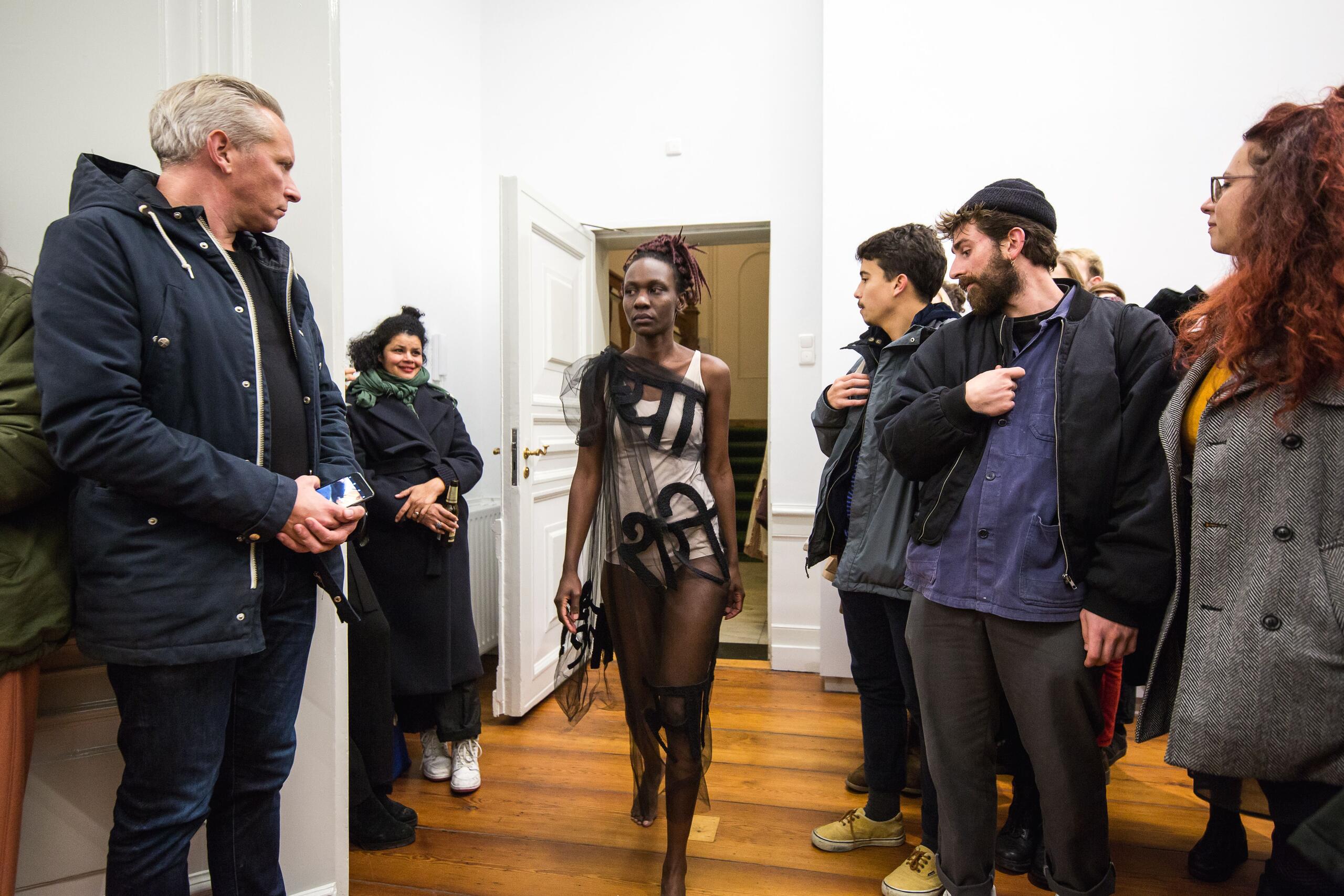
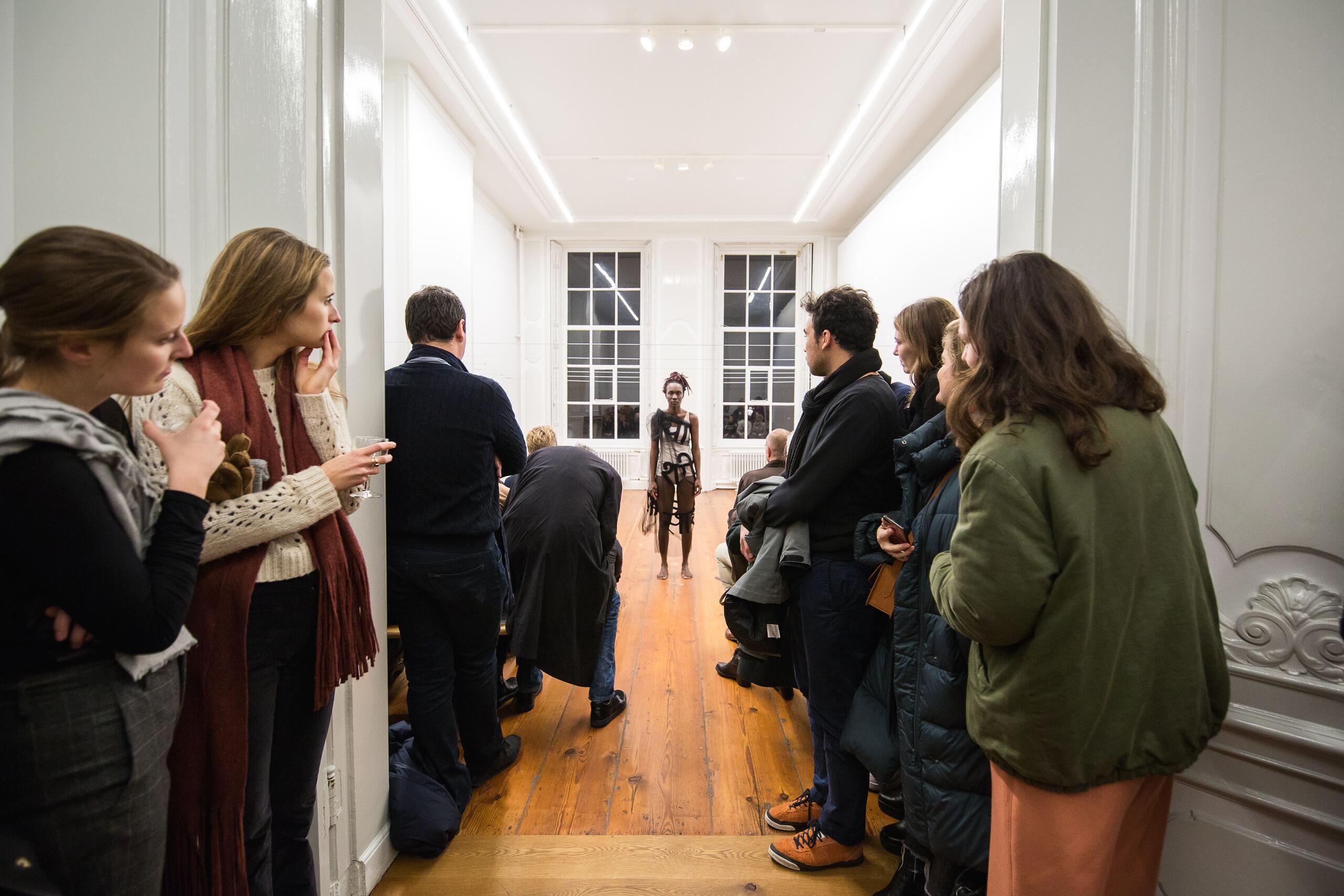
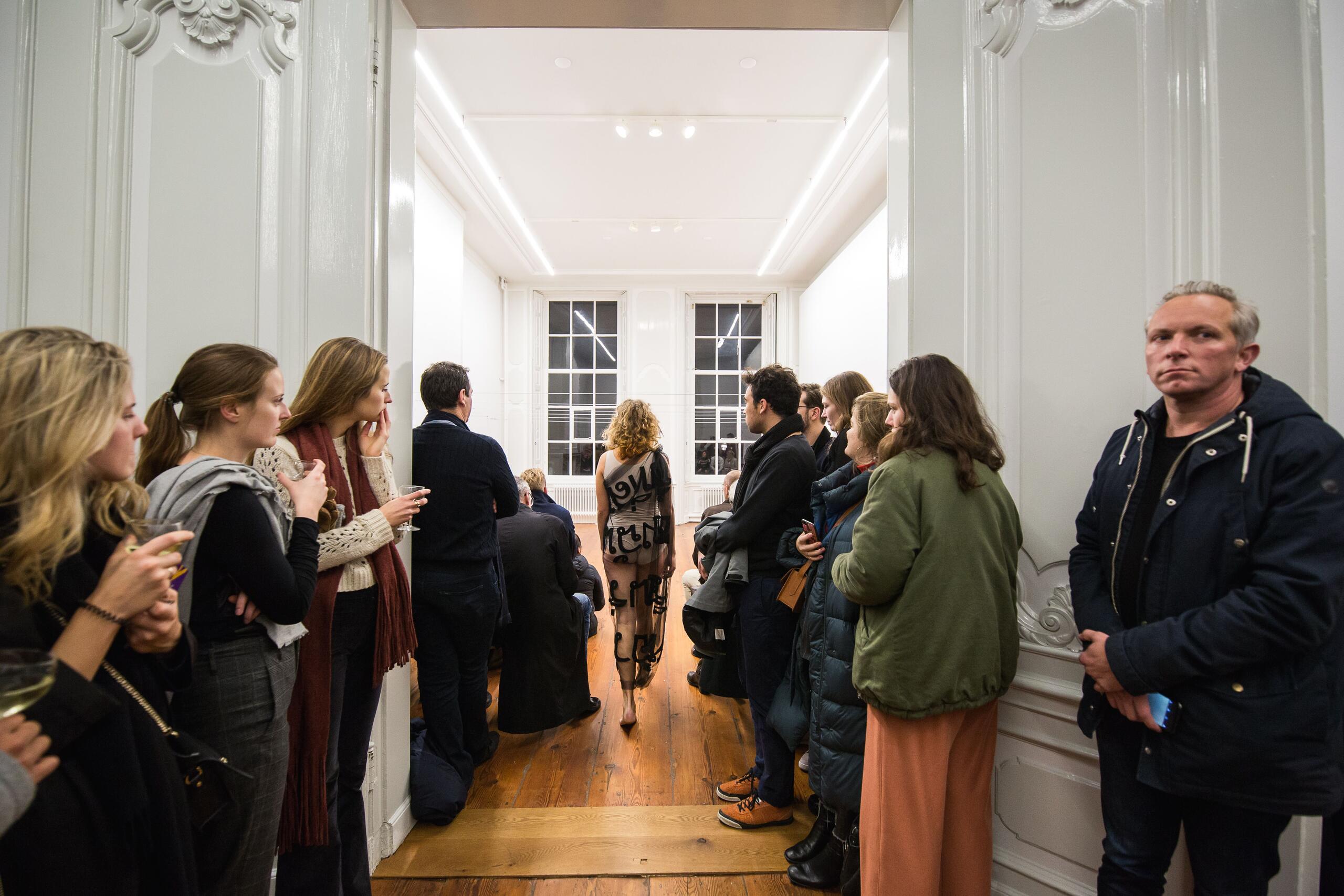
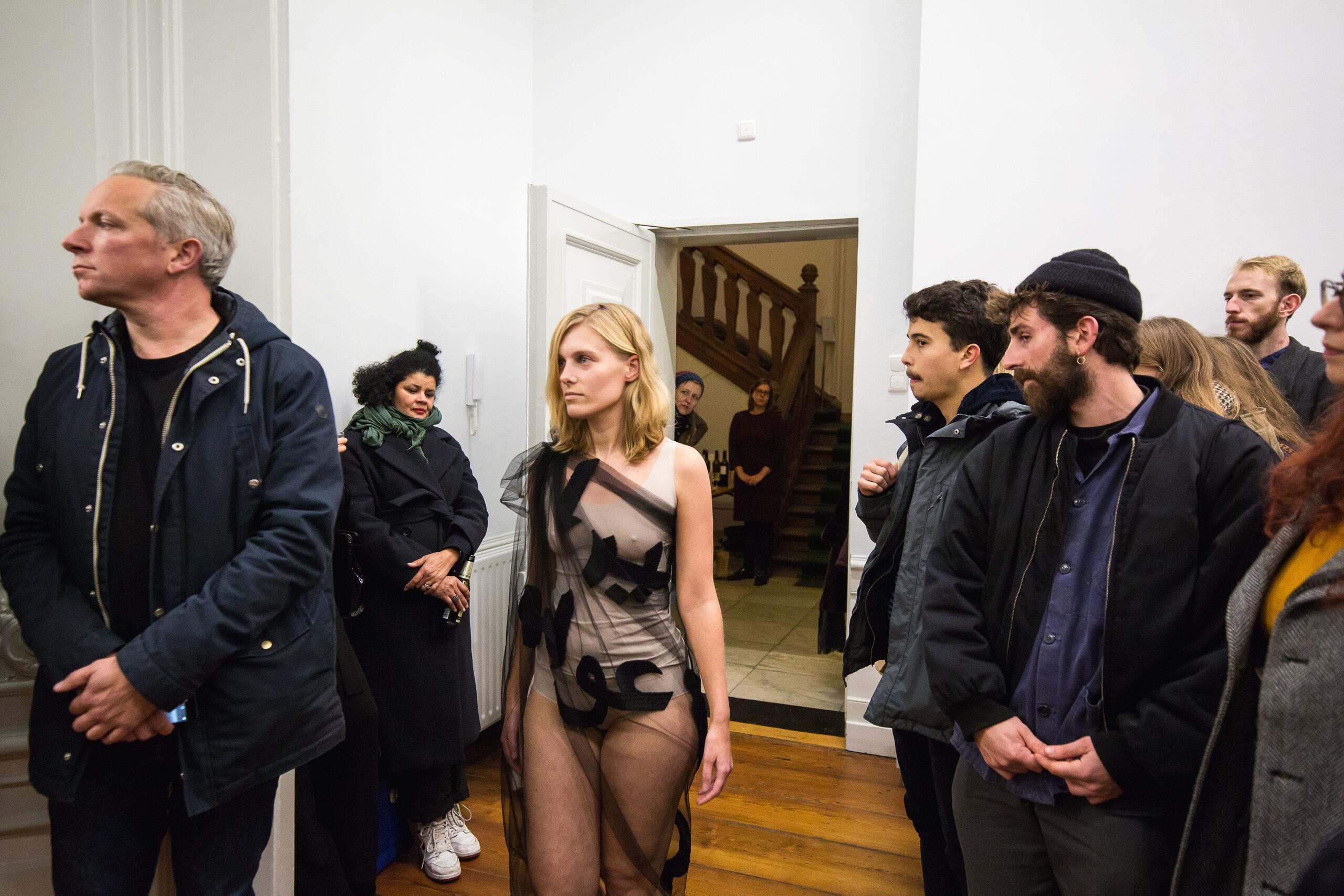
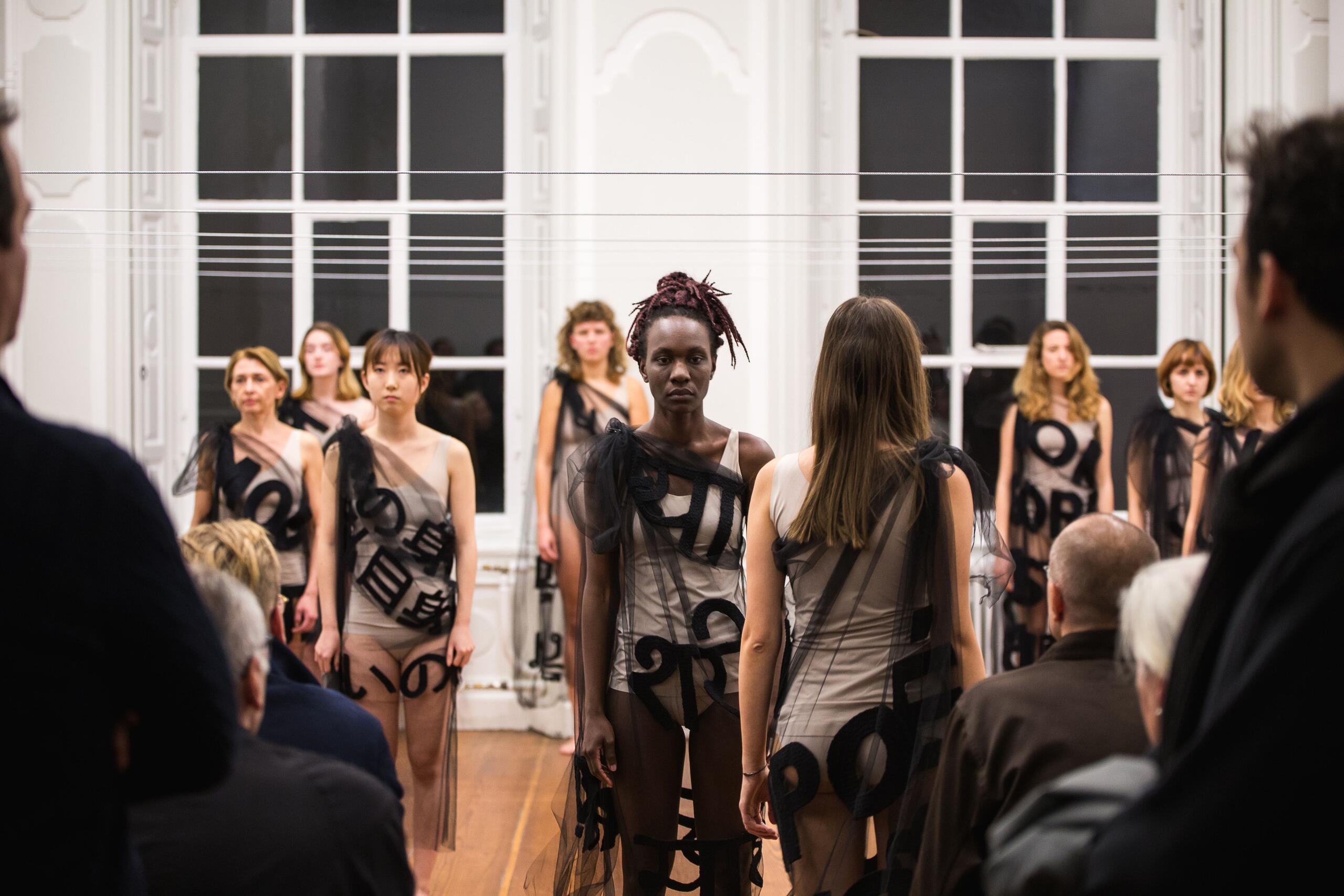
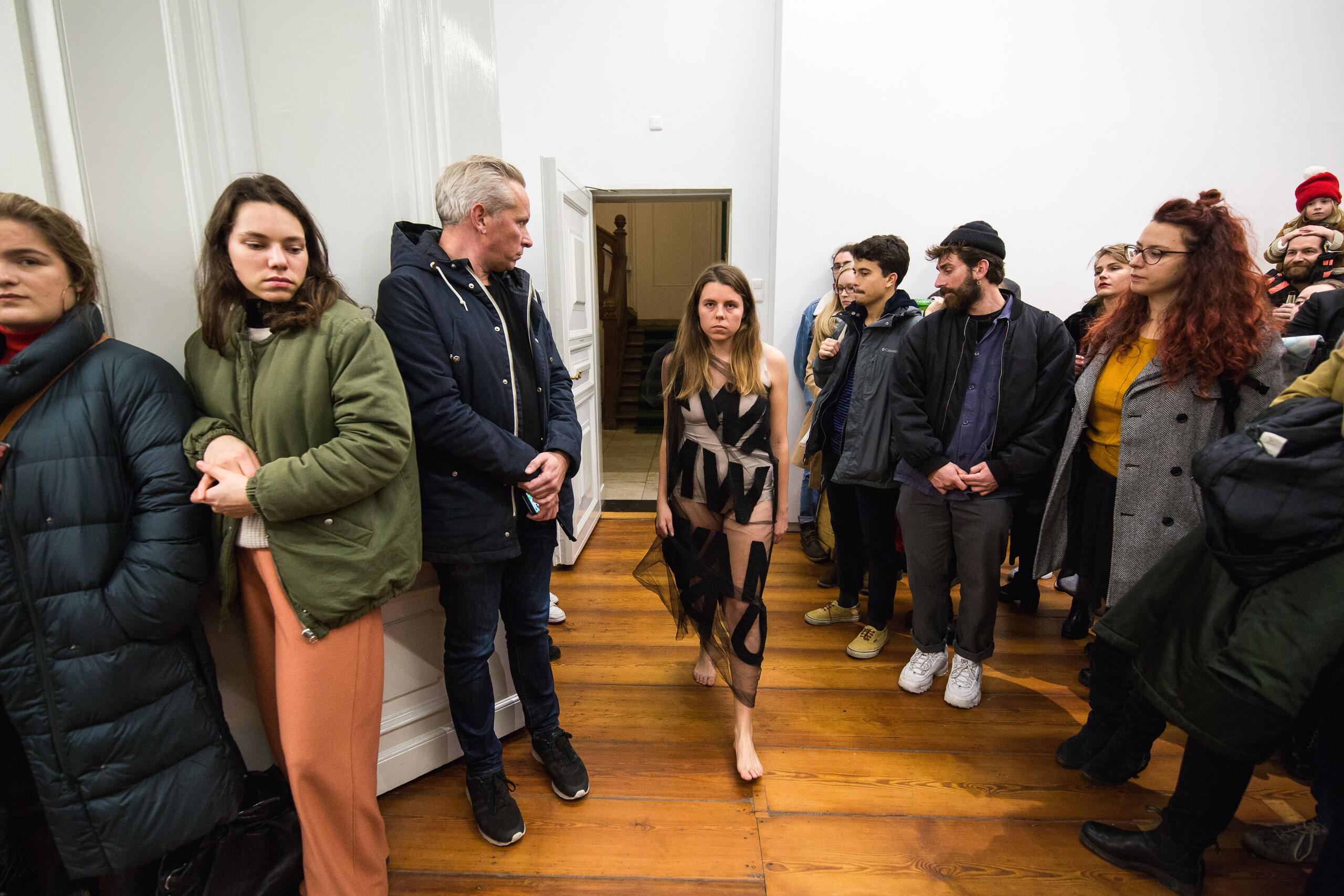
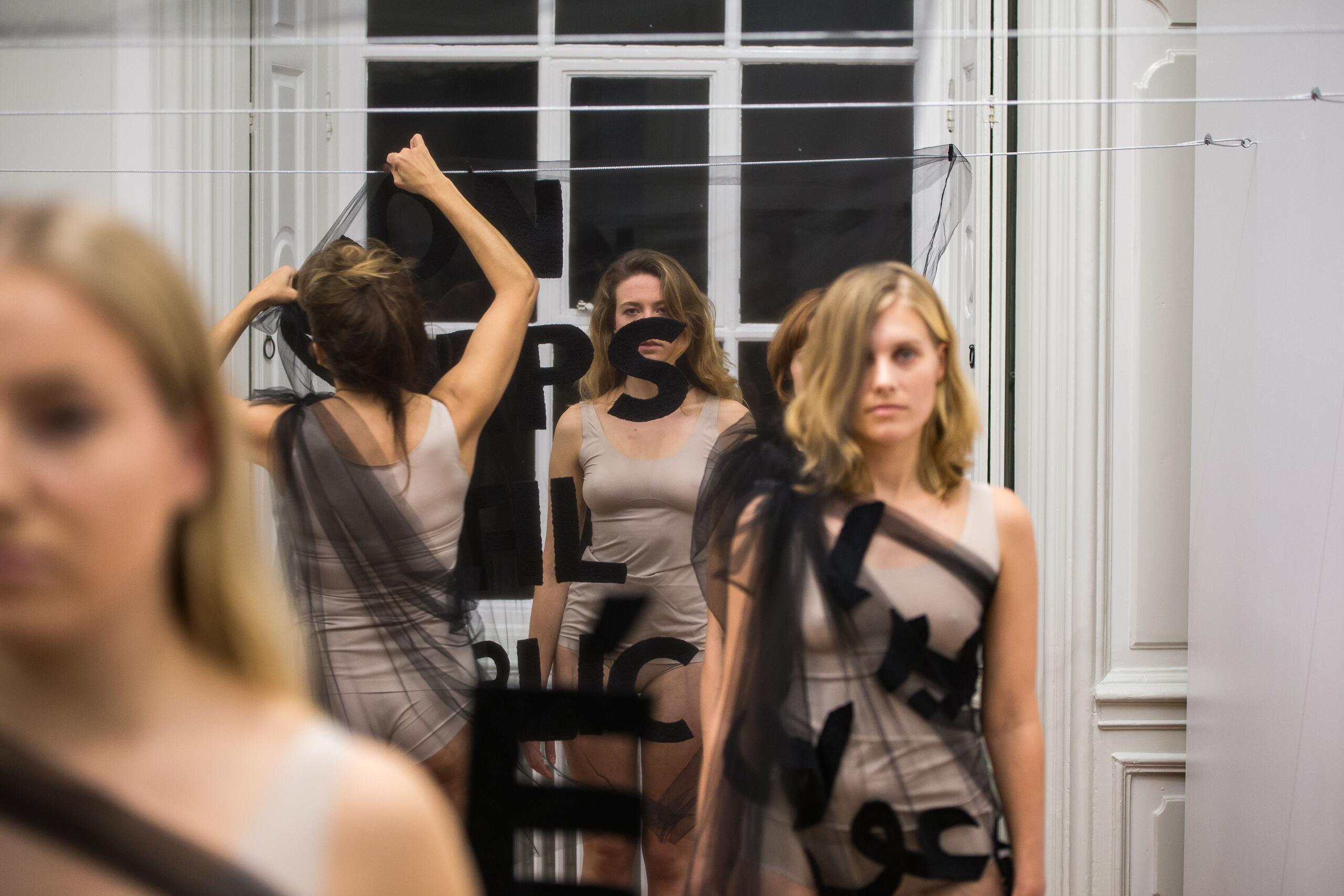
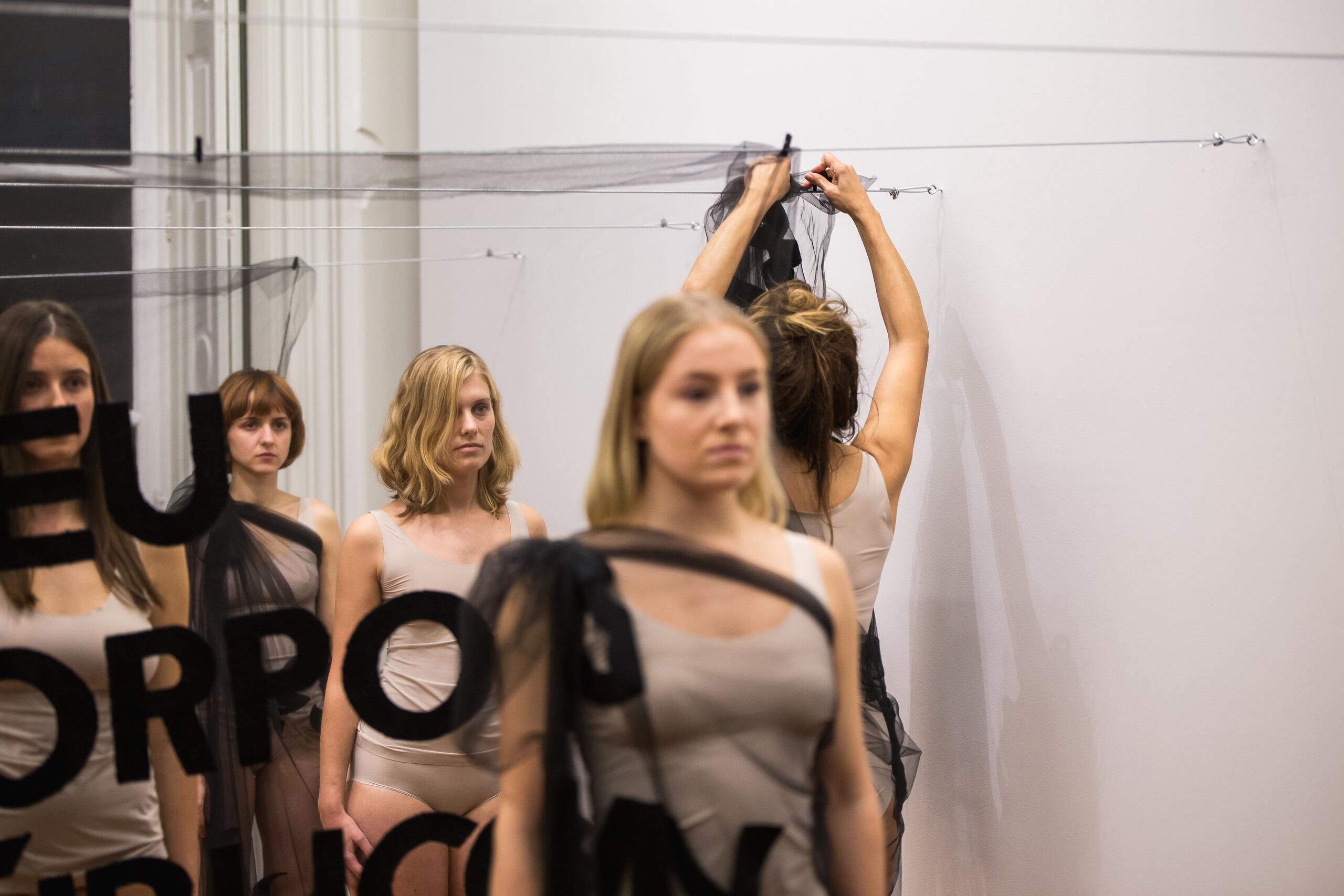
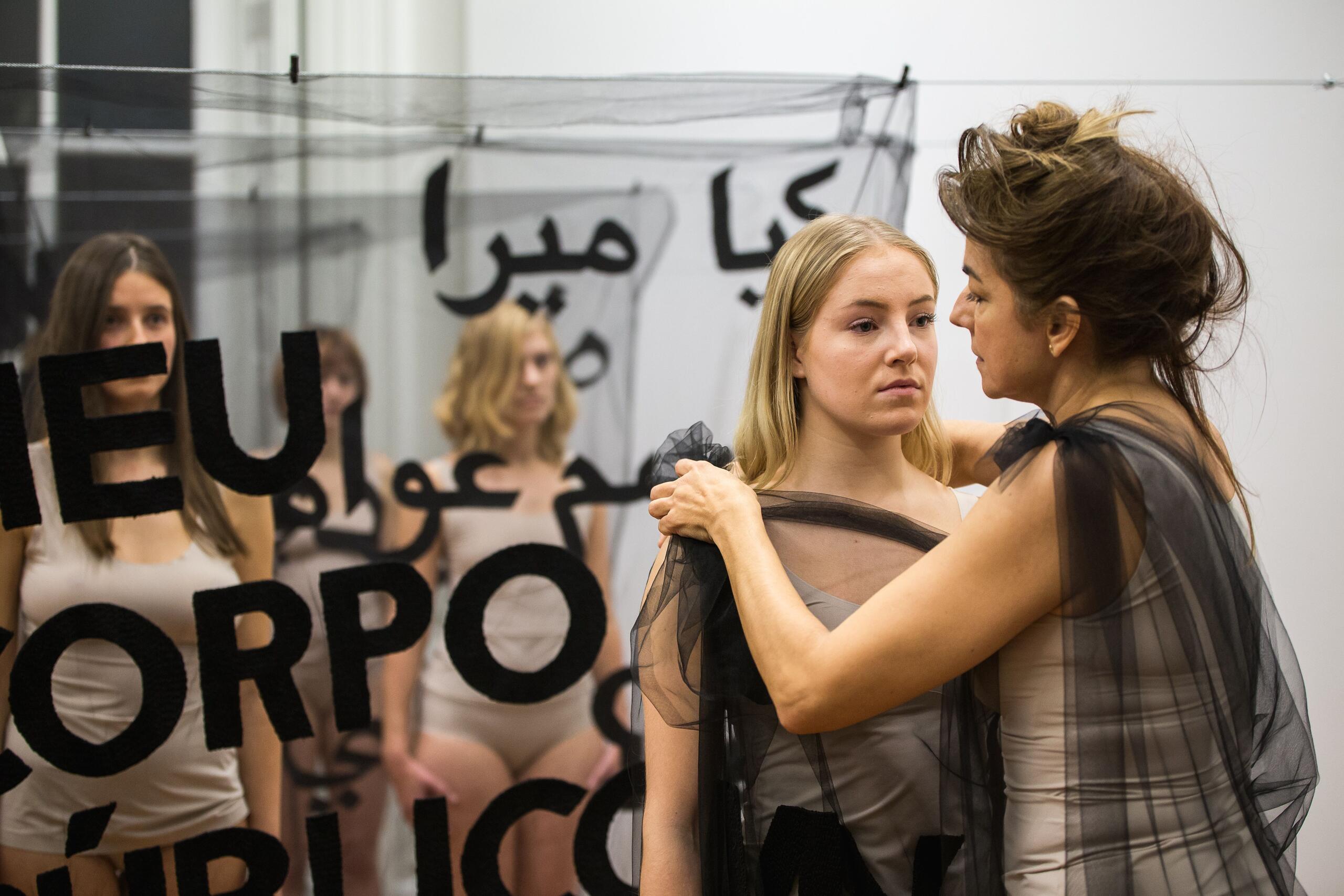
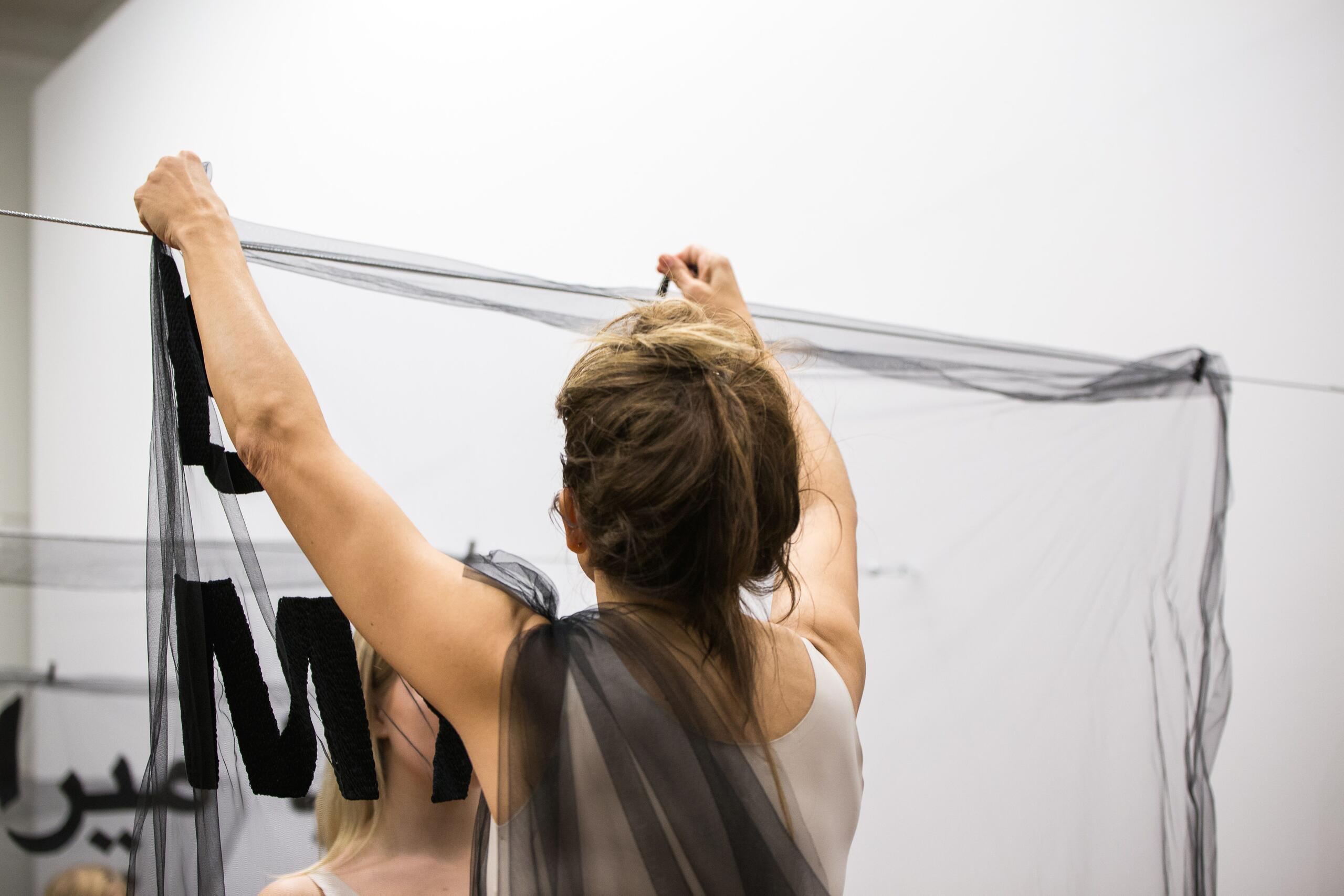
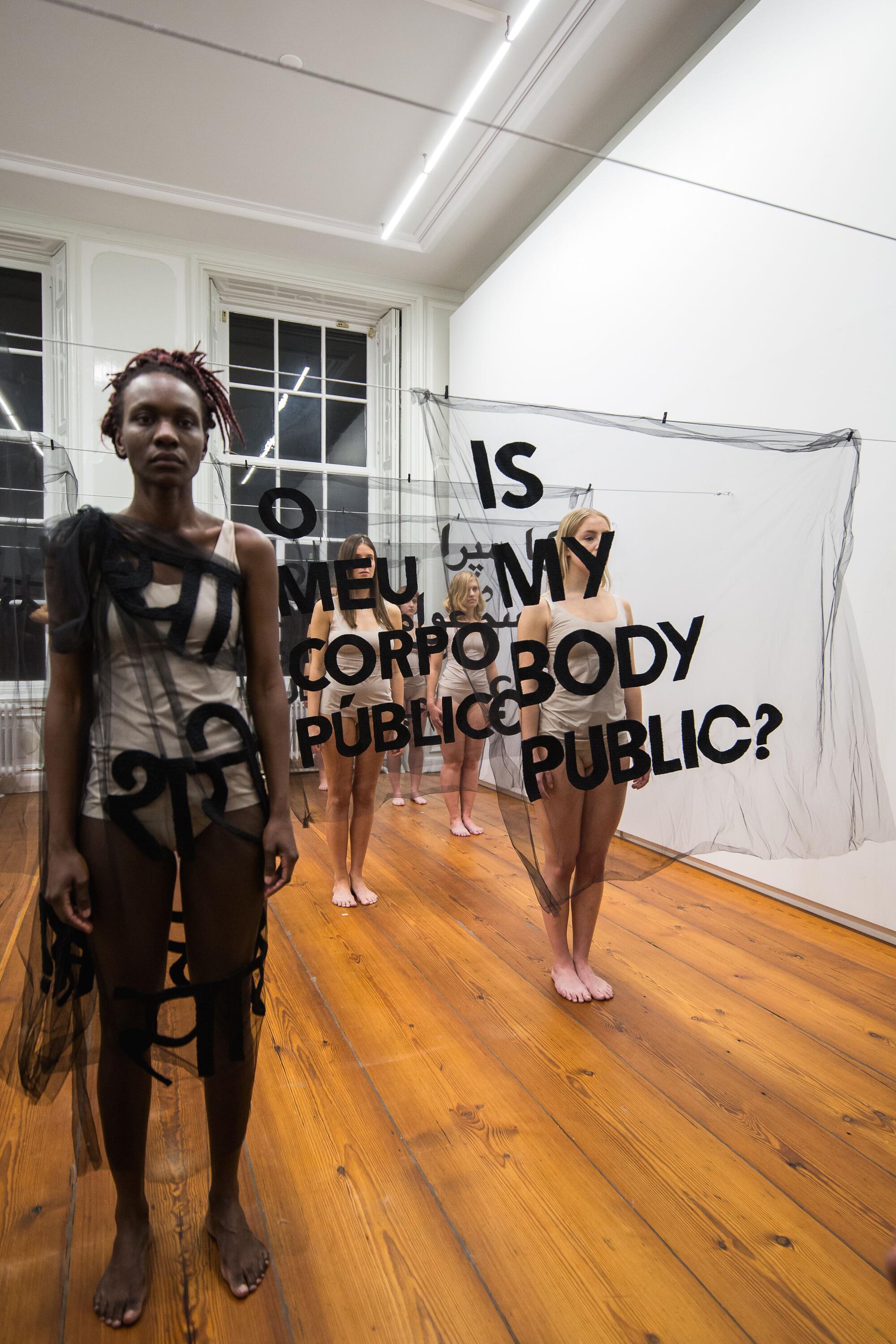
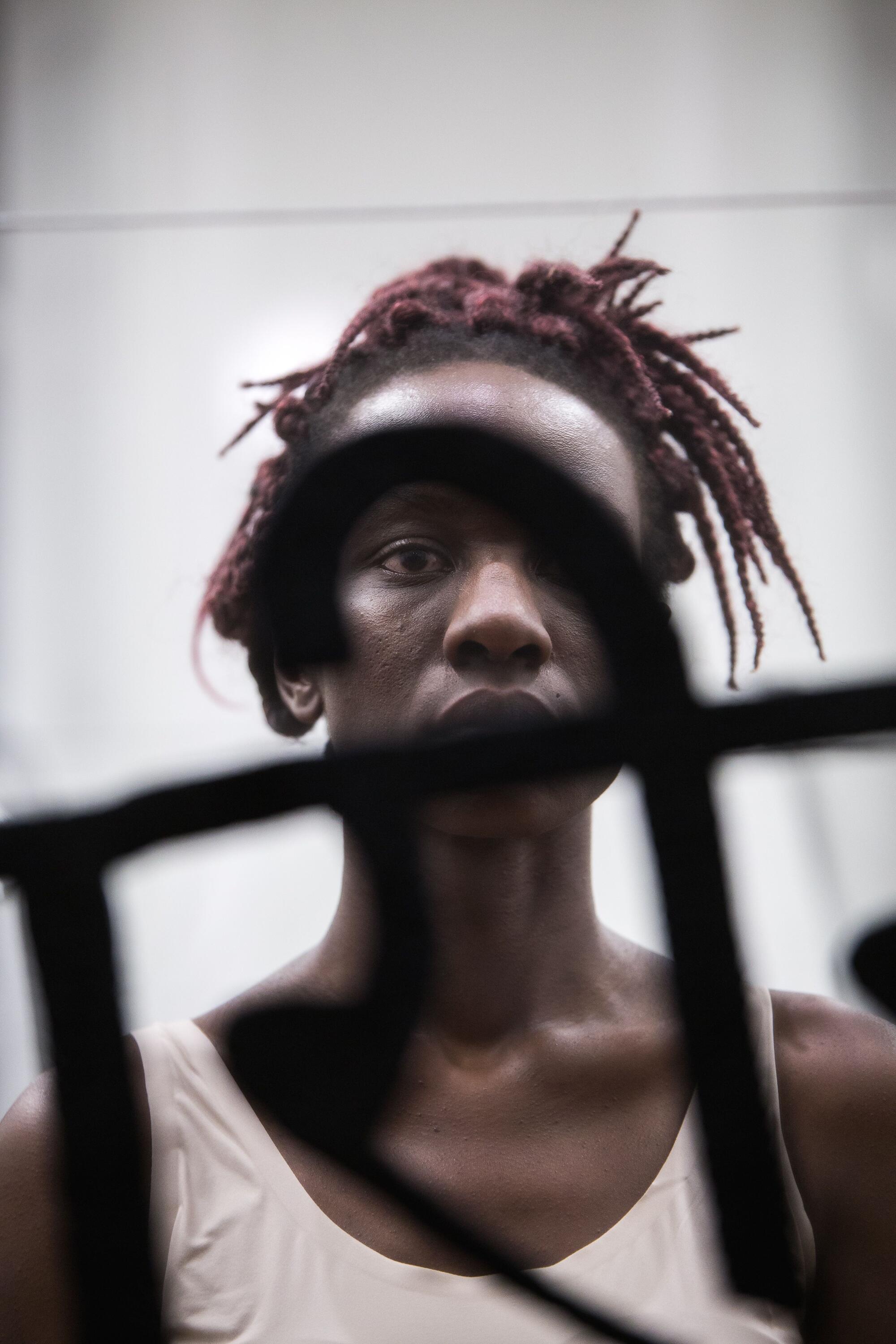
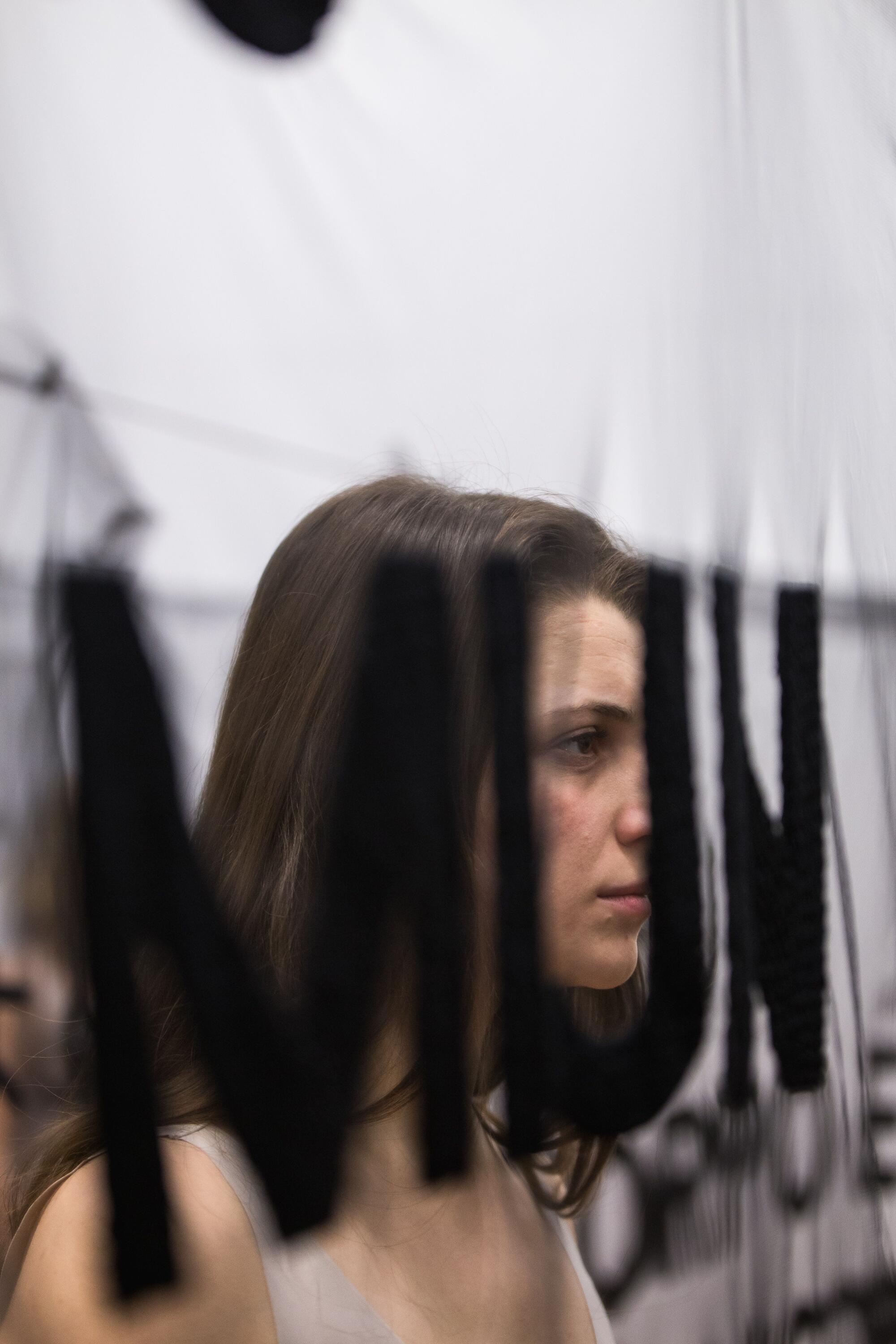
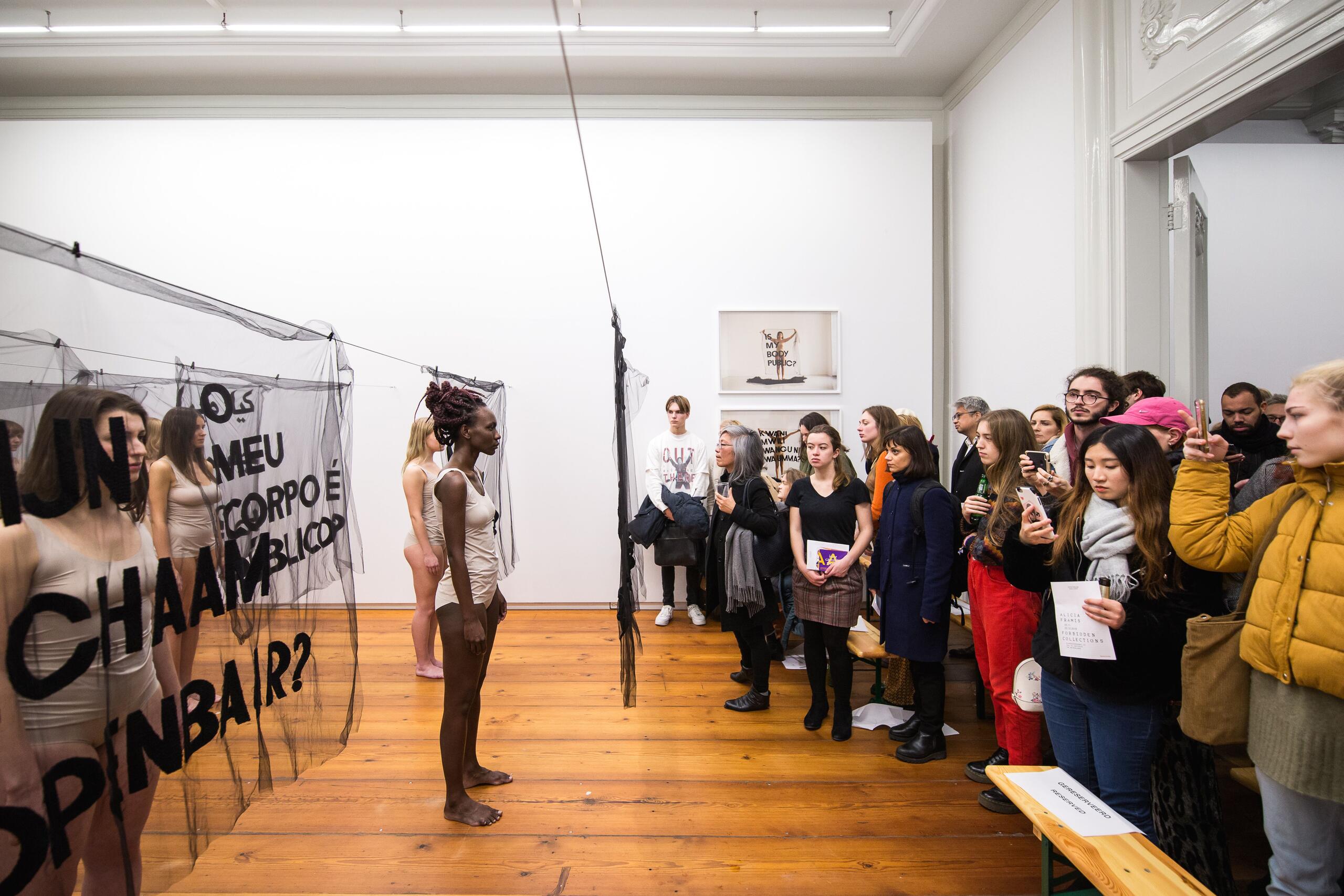
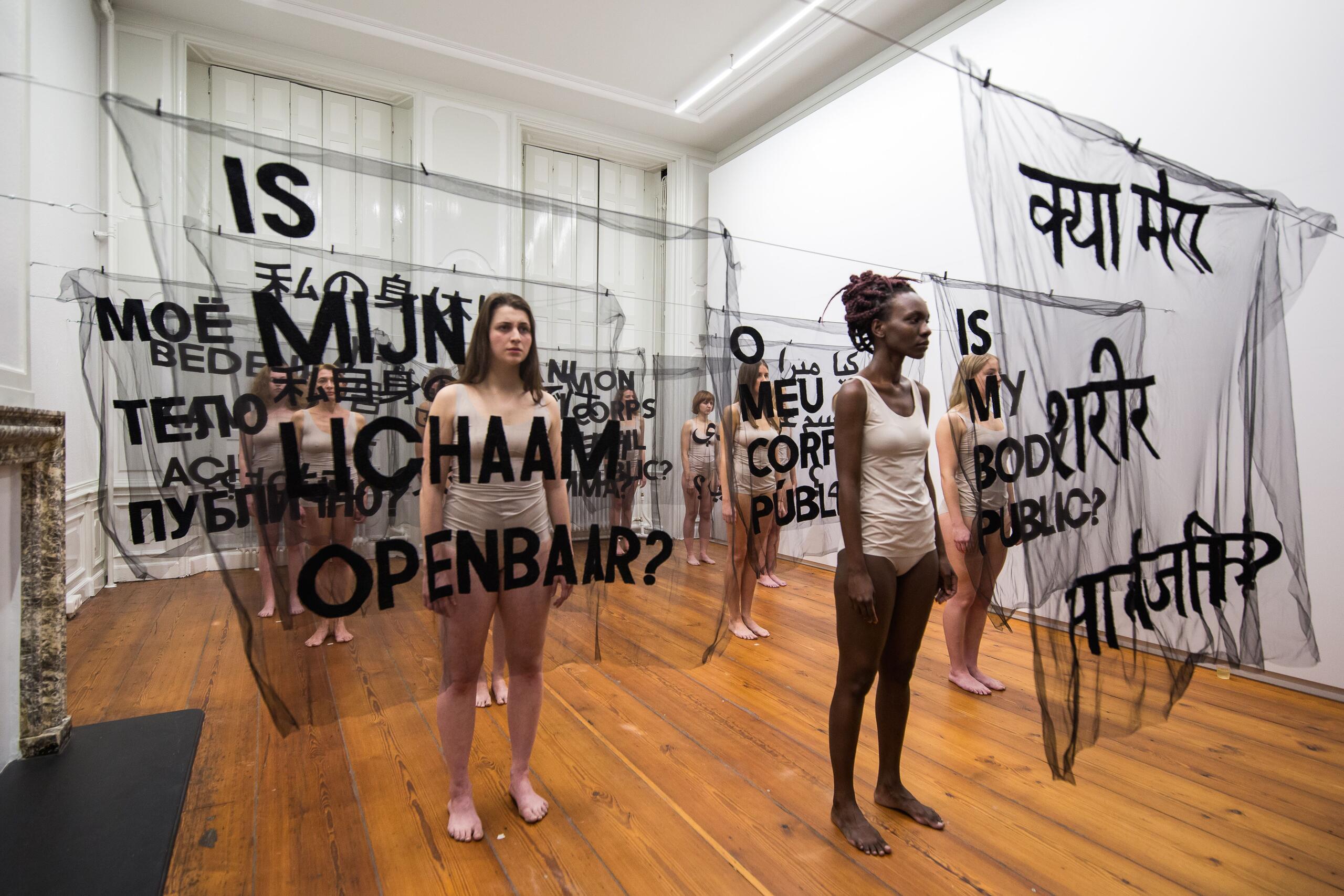
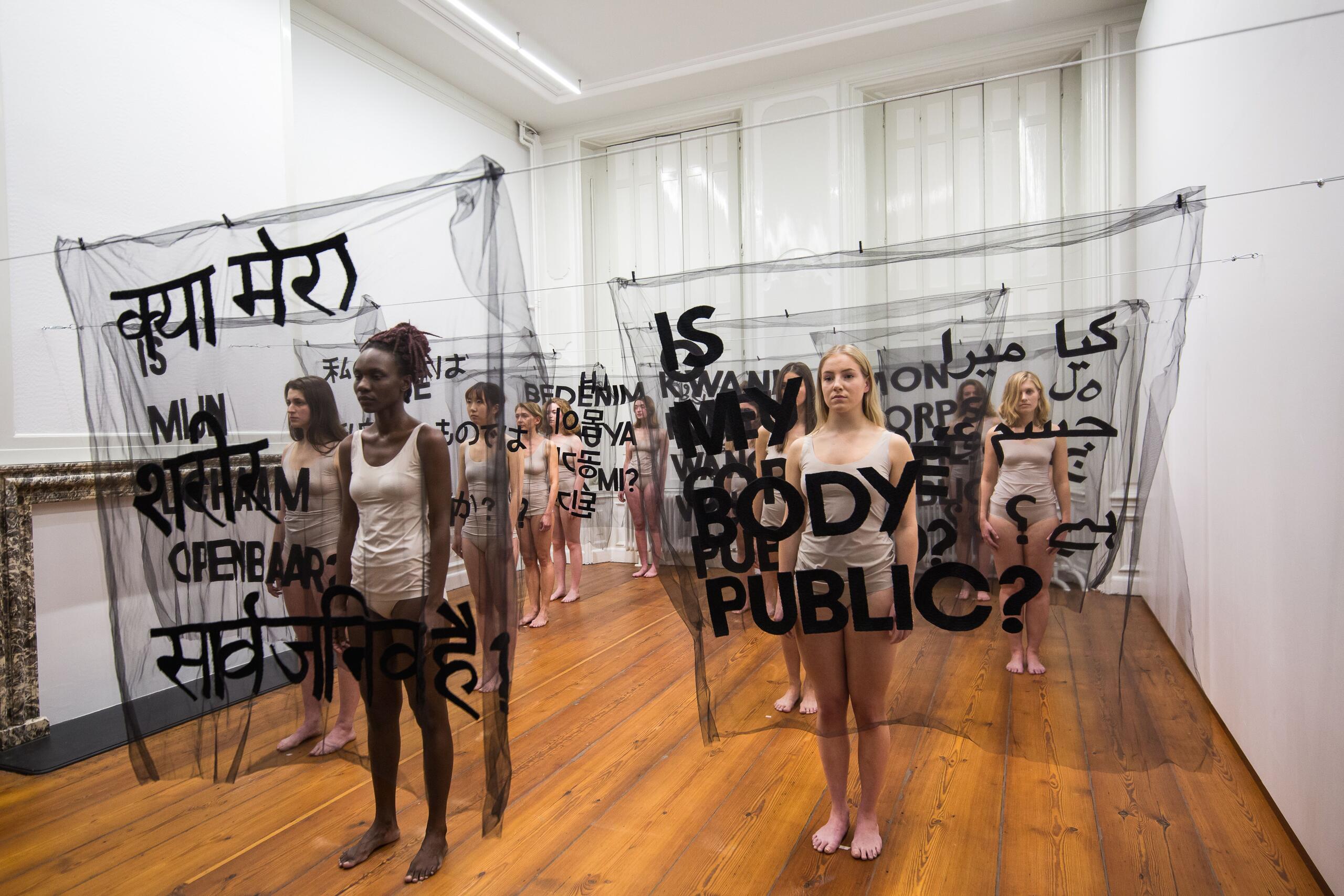
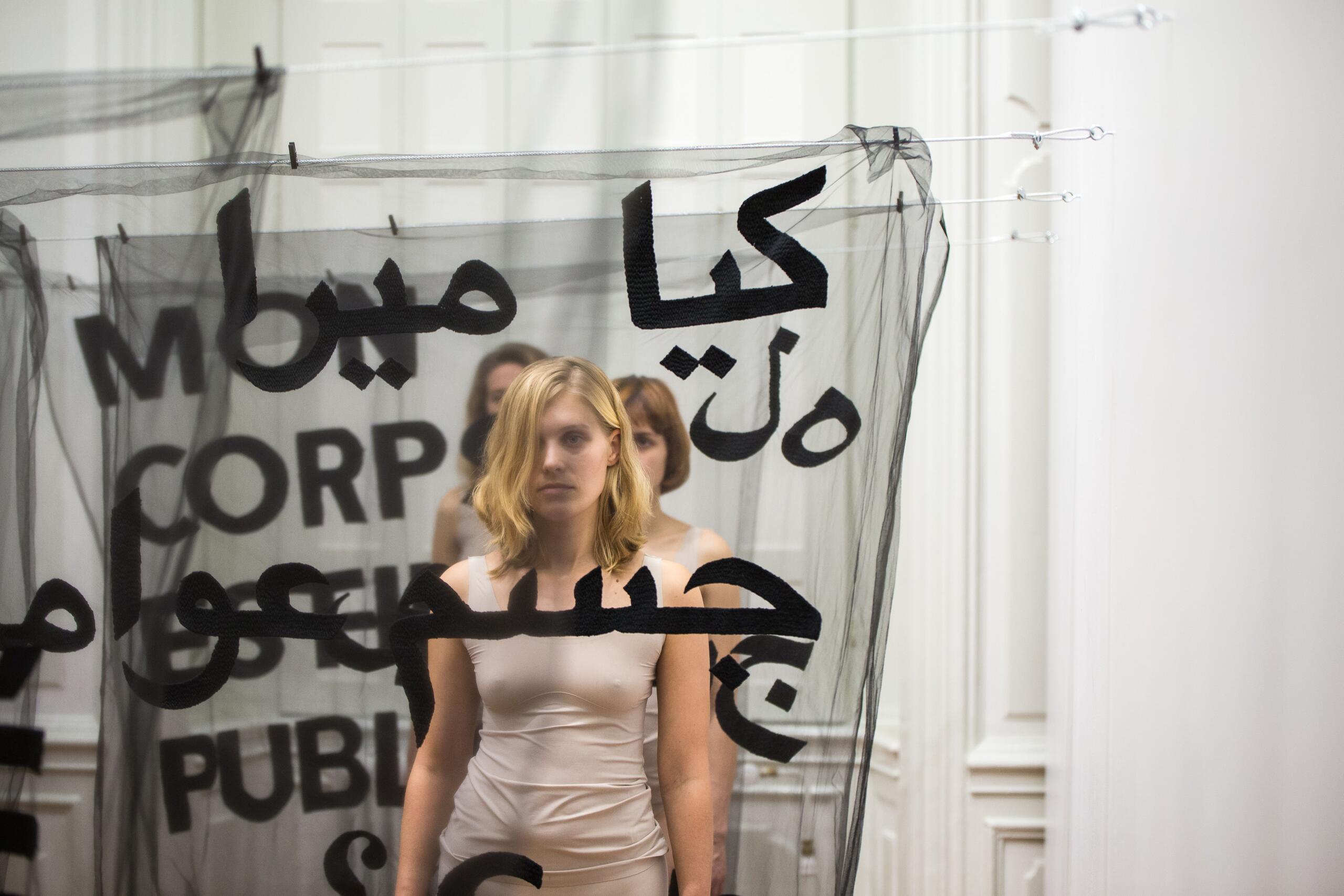
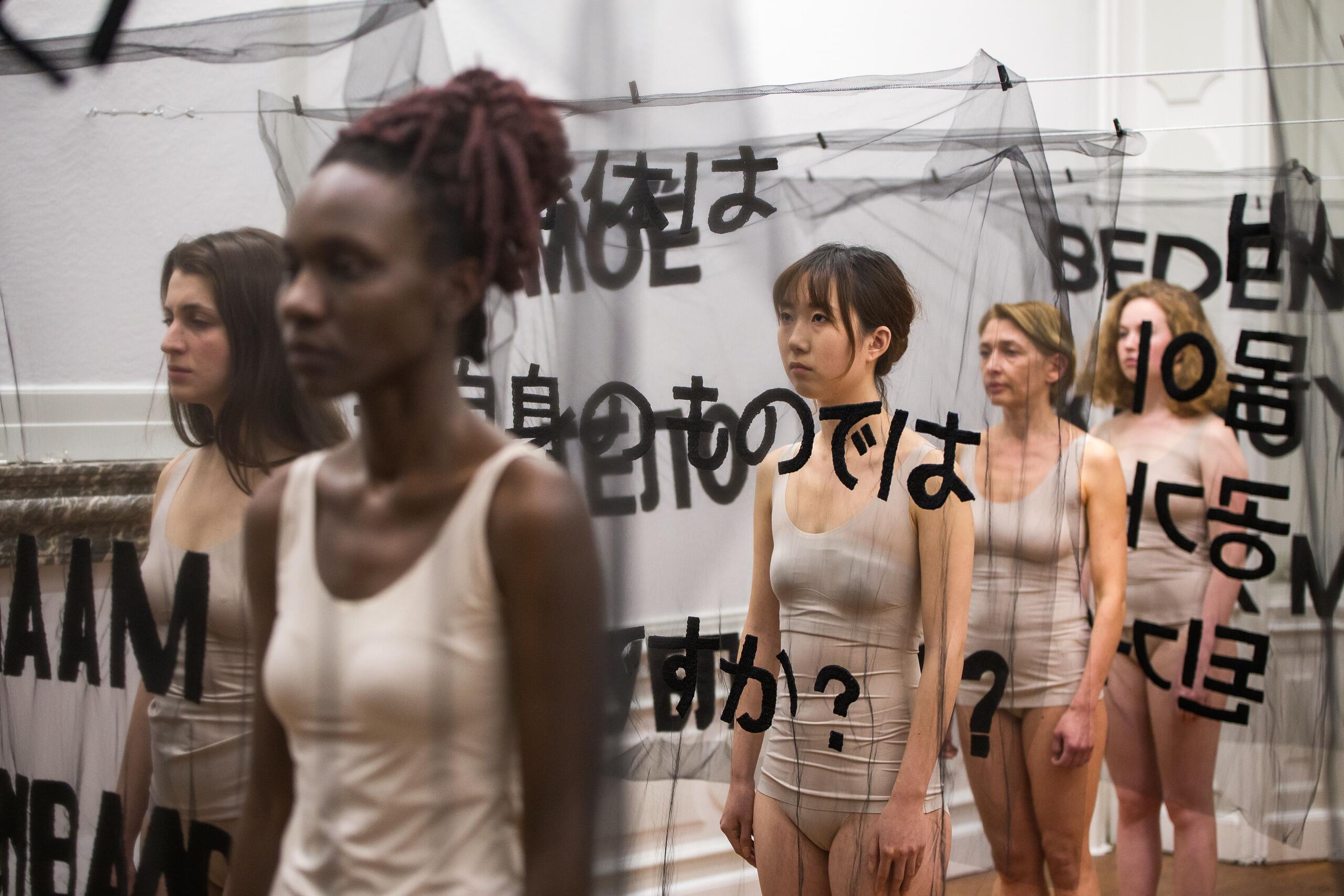
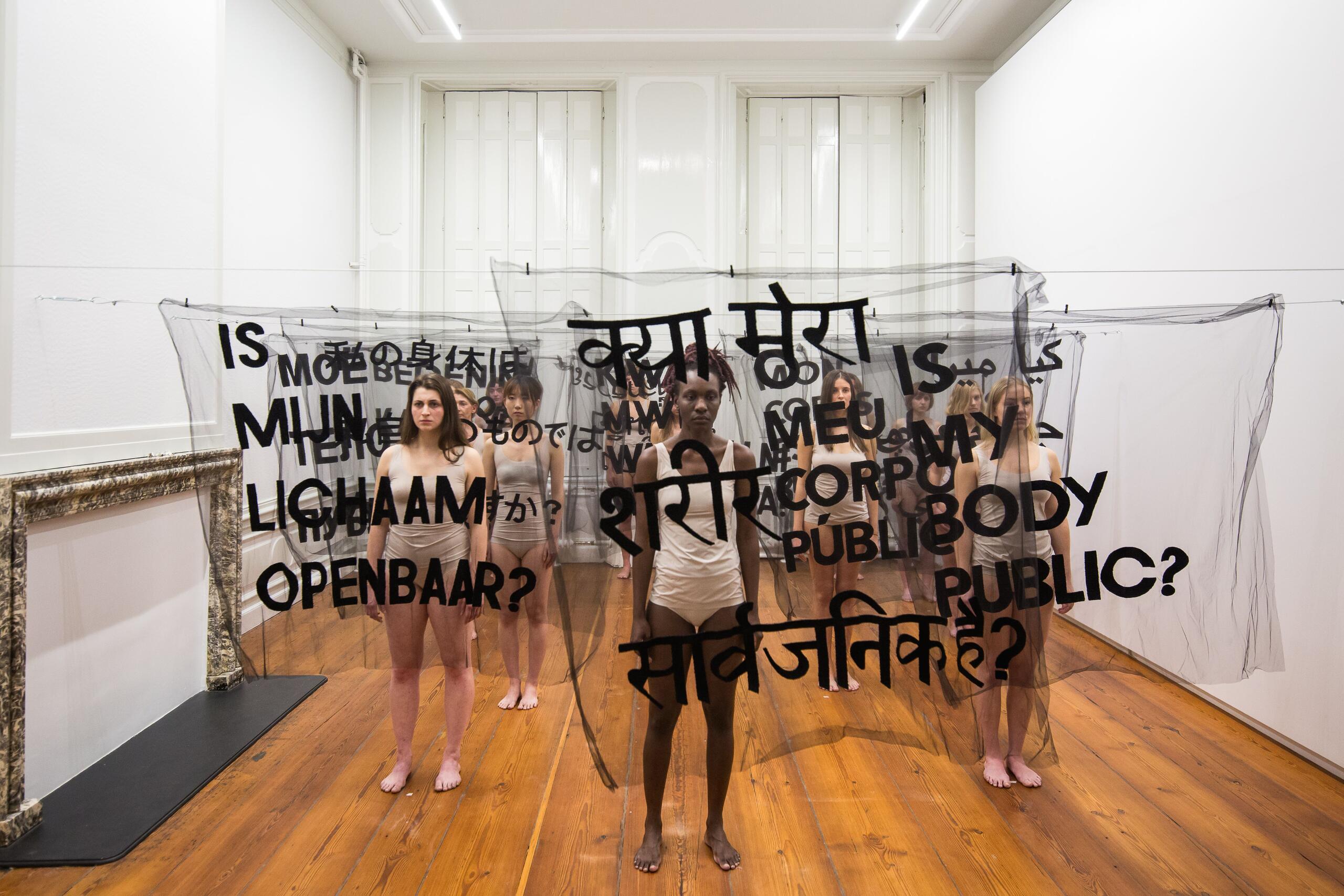
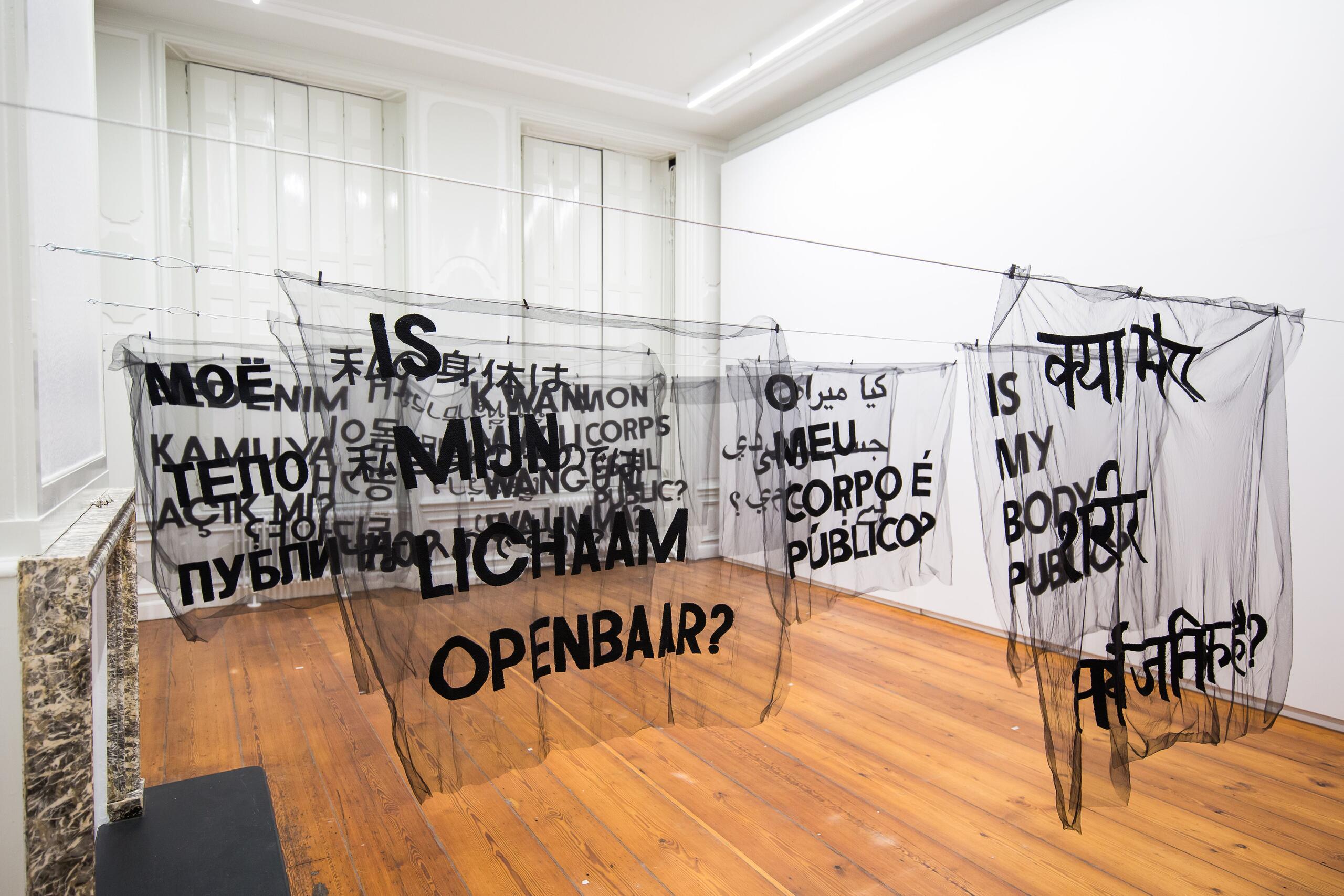
For this work Framis has new garments with which she explores the borders of that which is private and that which is public. The aesthetics of the dresses resemble that of lingerie, a material usually associated with the private realm, with moments of intimacy inside the home environment. The dresses are made from tulle, a delicate and transparent fabric, but are at the same time banners for public demonstration and used as such.
The dresses carry a strong message embroidered onto them. “Is My Body Public?” ask each of the fifteen dresses, in fifteen different languages. With the work, Framis wants to focus attention on the issue of women’s control over their own body. The slogan “Is My Body Public?” was translated by fifteen different women, each from the region where the specific language is spoken.
Is My Body Public? These dresses are used actively in performance demonstrations. During the performances fifteen women walk through the streets of the city centre towards the art gallery whilst wearing the dresses. The work introduces a new way of using demonstration against sexual violence and intimidation against women. The general passer-by is confronted with the women’s message and asked to reflect upon this. Upon arrival in the gallery the 14 women hang the banners up on a clothing line.
Is My Body Public? is a continuation of Framis’s 2002 fashion collection Anti_dog, which consists of 23 pieces of clothing made from bulletproof material to protect women against violence. In this work too Framis made use of demonstration and fashion as tools to question women’s public safety.
With Is My Body Public? Framis questions what is public and what is still private in today’s world. Nowadays it seems as though privacy is something of the past. Our movements, both physical and digital, are followed constantly. We have given up a lot of our privacy with the introduction of the internet and with new technologies. When going through airport security we are closely, sometimes quite intimately, searched by guards. The government collects all kinds of data about its citizens that is in fact very private information. Framis asks herself where her privacy ends. Where does the fear of the other and the need to control people by gathering as much information as possible begin?
The issues of privacy and body politics Framis discusses in this work take on a different, more specific meaning for women. Women in many countries worldwide are not allowed to make decisions that concern their body, for example in places where women have to obey certain dressing rules or codes. At the same time women’s bodies, appearances and ways of dressing seem to be a subject that the public, in particular men, think they can publicly comment on or critique however they like, for instance by harassing women in the streets. Women’s bodies often seem to be viewed as public property. By posing the question ‘Is My Body Public?’ Framis literally exhibits the supposed ‘availability’ of the female body. With the performance Framis confronts the viewers with the objectification and sexualisation of women’s bodies that is omnipresent in today’s society. The discussions on sexual violence and intimidation are relevant not only in the Netherlands and in Framis’s home country Spain but throughout the world. In many places in the world women are not able to undergo legal, safe abortions and in many places where this is possible women are judged for doing so. Women’s bodies are in such cases subjected to (patriarchal) government regulations or conservative views that influence the private lives of women by deciding over women’s bodies and their sexual and reproductive rights. These are just a few examples of social issues regarding sexism and women’s rights that lead to the question Framis is posing with this work.
In the 1970s feminist art movements adopted the term ‘body politics’ to stand up for reproductive rights and fight against objectification of the female body and (sexual) violence against women. ‘The personal is political’ was a slogan that was used a lot at the time. Despite the fact that this is almost 40 years ago, the slogan still seems appropriate. The choice of the material in Framis’s dresses, with the embroidery, does not only bring to the fore the intimate nature of this material but also makes a statement. Embroidery has traditionally been, and in fact still is, associated with ‘a women’s craft’, as inferior to other, more ‘masculine’ art forms such as panting. In the 1960s feminist artists adopted the medium with the aim to give it the same appreciation and status as so-called ‘high art’. Framis seems to reference this and use it at a statement for equality.
Is My Body Public? offers a tool for women to explore different, playful ways of demonstration against issues such as (systematic) sexism. By working together with women from different backgrounds in the performance the work gains a participatory and global character.
Social relationships are a defining factor in the work of Framis. Since the 1990s artists have become increasingly interested in engaging the public and making them co-maker of their art works.For Framis active participation of the public and social interaction between people is something she has been researching ever since the beginning of her artistic practice in the 1990s. Art Historian Claire Bishop in her 2002 book Artificial Hells: Participatory Art and the Politics of Spectatorship defines the term ‘Participatory Art’ to refer to art forms in which the people involved create or co-create the artwork. Framis likes to work in a way where she is co-dependent on the people that engage with her work. She collaborates with different people, such as the embroiderers and performers, to make the work. Moreover, the gallery space is empty before the women enter and hang the banners up. The exhibition is thus also made through the act of the performance and the participation of the women performing. The performers confront the visitors inside the gallery upon arrival by staring straight at them. This act could be interpreted as a returning of the ‘male gaze’.
Is My Body Public? discusses women’s rights in today’s society and questions to what extent our bodies belong to the public or private realm. The work can be seen as a call for action, demonstration and reflection. Art, feminism, performance and activism meet in this work.
Supported by: Mondriaan Fonds and Elan Fashions
Thanks to: Karen Park-Goude
Photos by: Maarten Nauw
Text: Nina Svenson